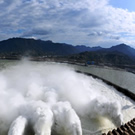
A hydroelectric plant is composed of civil works and hydraulic dam (or crossbar barrier, gripping system, bath of load, works for conveying and refund, penstocks, building of the central) and electromechanical machinery (hydraulic turbines, generators, electrical panels, control systems).
The diagram general a hydroelectric plant comprises:
- A work of damming of the river bedof the river upstream of the plant, consisting of a cross or a dam, which can determine a volume of the invaded to the riverbed to allow or not allow the accumulation of natural flow rates; usually the work of jack and equipped with one or more flaps of discharge for the cleaning of the pelvis against his interrimento;
- One or more flaps of grip,that i can be followed by a bath of calm for the sedimentation of sand carried by the current;
- A bypass channel, which may be in whole or in part in the gallery;
- A charging tank, usually equipped with exhaust means;
- One or more penstocksthat convey the water to the hydraulic turbines;
- A plant for the production of electricity, in which they are installed one or more groups turbine-generator;
- A channel of refund of the turbinata water in the river bed of the watercourse downstream of the plant.
Not all the plants are present all the works mentioned above. Plants low jump does not usually have the penstock, while many plants with a high jump, especially if recent, do not have the bypass channel, but only the penstock.
The water is appropriately derived via the works of gripping and conveyed into the tub of load from which extend the channels and/or the penstocks that supply power to the hydraulic turbines. The impeller shaft of the turbine is connected to an electricity generator (alternator). The water used in the turbine is released downstream of the plant without any consumption of the water upstream.
Ultimately a hydroelectric plant, by exploiting the topographical difference existing between the tank loading and the production plant, transforms the potential energy of the water into mechanical energy of rotation of the turbine that is converted directly into electrical energy by the generator. Hydroelectric plants are divided into plants to the tank, a basin or flowing water.
The plants to reservoir and basin are able to adjust the use of the water in the system through the storage capacity created by these works. The plants to flow directly use the useful range available in the riverbed of water course without the possibility of adjustment of flow rate to the system.








